The 2021 Continental Cup final saw two teams at differing ends of the WSL face off against each other for the first silverware of the season. Chelsea Women were looking for their eighth major trophy, and were the defending champions, having beaten Arsenal Women in last year’s tournament. The majority of Bristol City Women’s squad, meanwhile, have never been to a major final before, so this was an opportunity for them to go out and show what they can do. This tactical analysis will look at how Chelsea were able to dominate the game, which took place at Vicarage Road, home of EFL side Watford, helping them to win by a record-breaking margin. The analysis will also look at the tactics interim manager Matt Beard has introduced since temporarily replacing Tanya Oxtoby, who is on maternity leave.
Lineups
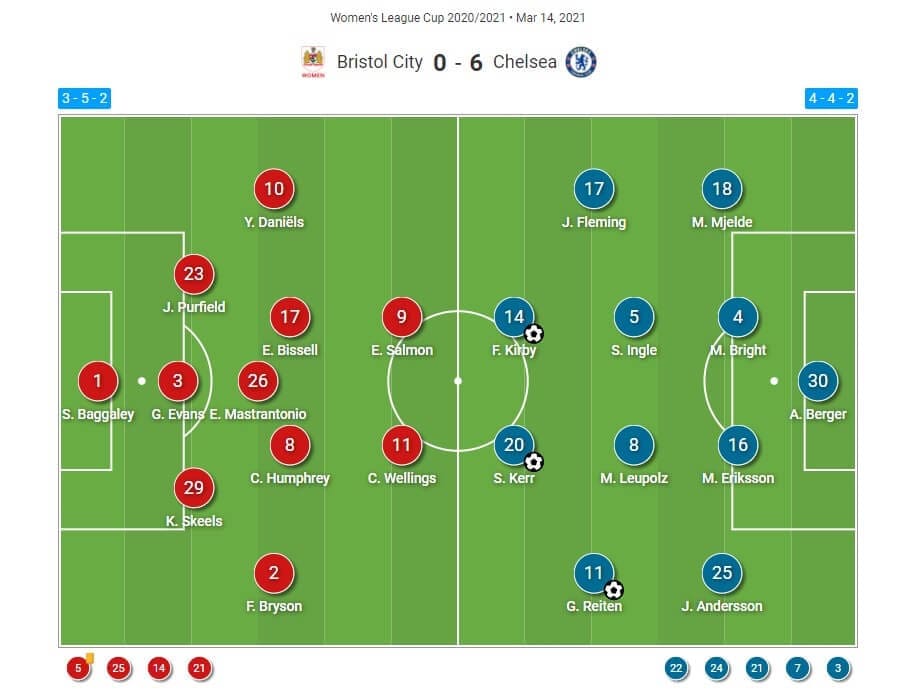
Bristol City Women changed from the 4-2-3-1 formation that they used against Reading Women last weekend into a 3-5-2, with three changes being made to their starting XI. Defender Laura Rafferty, on loan from Brighton and Hove Albion Women, and midfielders Aimee Palmer and Molly Pike, the latter of whom is on loan from Everton Women, made way. In their places, Bristol brought in on-loan teenage Reading defender Kiera Skeels at the back, whilst Australia midfielder Ella Mastrantonio and Emma Bissell came into the midfield. Belgium forward Yana Daniels and right-back Faye Bryson operated as the wing-backs, with Charlie Wellings playing alongside new England striker Ebony Salmon in attack.
Chelsea Women, meanwhile, made four changes of their own from their midweek Champions League draw at Atletico Madrid Femenino. Striker Beth England was ruled out with concussion sustained in that game, whilst Ji So-yun, Niamh Charles and Pernille Harder all dropped to the bench. Into the team came captain Magdalena Eriksson, who started alongside Maren Mjelde, Millie Bright and Jonna Andersson in their usual first-choice defensive line, whilst midfielders Jessie Fleming and Guro Reiten played as the wingers, and Sophie Ingle came into central midfield. Sam Kerr and Fran Kirby operated as the front two, giving Chelsea a fearsome-looking attack.
Chelsea Women’s attack
Chelsea Women looked to get forward at every opportunity, which came from their attacking tactics. We can see below how they looked to create opportunities and space in Bristol City Women’s third.

Bristol’s back five meant that they had three players in the middle, making it theoretically harder for Chelsea to get between them and into the space behind. Therefore, to beat this, Chelsea looked to form triangular structures in attack, as we can see in this image. These involved Sam Kerr and Fran Kirby, but also Guro Reiten, with the Norwegian operating as the creative attacking midfielder behind the front two. By forming these structures, Chelsea could then move the ball around the Bristol defenders with pace, as Reiten has done here. The pace that the ball moves at makes it more difficult for Bristol to anticipate where the ball is going, and so can’t organise themselves to stop the Kerr scoring here. Therefore, this was one way that Chelsea looked to beat Bristol’s defensive setup.
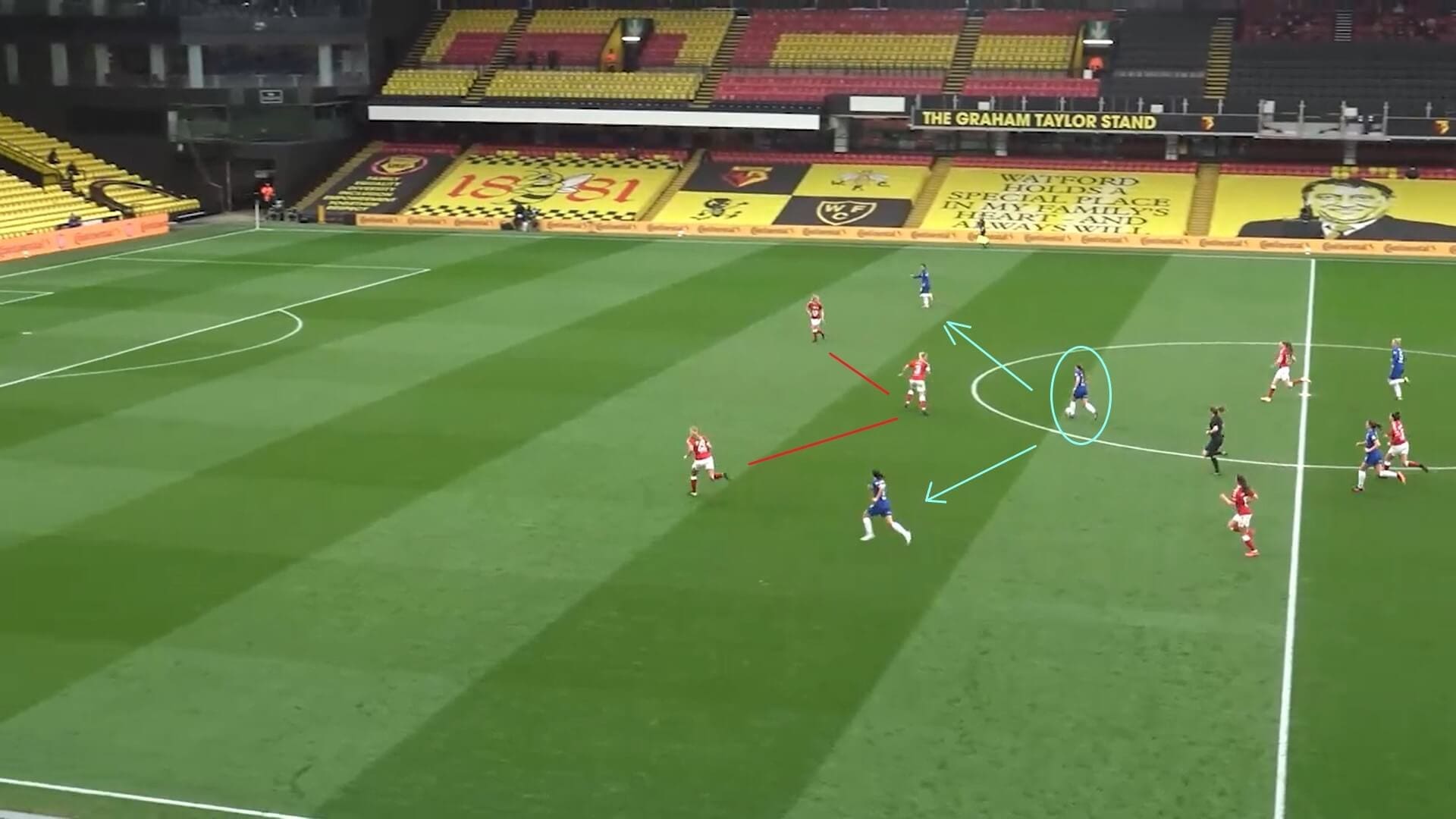
This attacking tactic also worked because all three players involved knew what to do when in these situations. Here, Kirby is in the attacking midfield role, with Reiten and Kerr are providing her with passing options. Bristol’s wing-backs getting further forward allows the two Chelsea attackers furthest forwards to split either side of the centre-backs, isolating them from the rest of the team. The blue arrows show how this gives Chelsea two passing options, so, if Bristol move to defend one player, the ball can go to the other, and if both are closed down, then there will be a gap between for Kirby to move through herself.
Therefore, we can see how Chelsea’s clever tactics helped them to create options, even with an extra Bristol defender to get past.
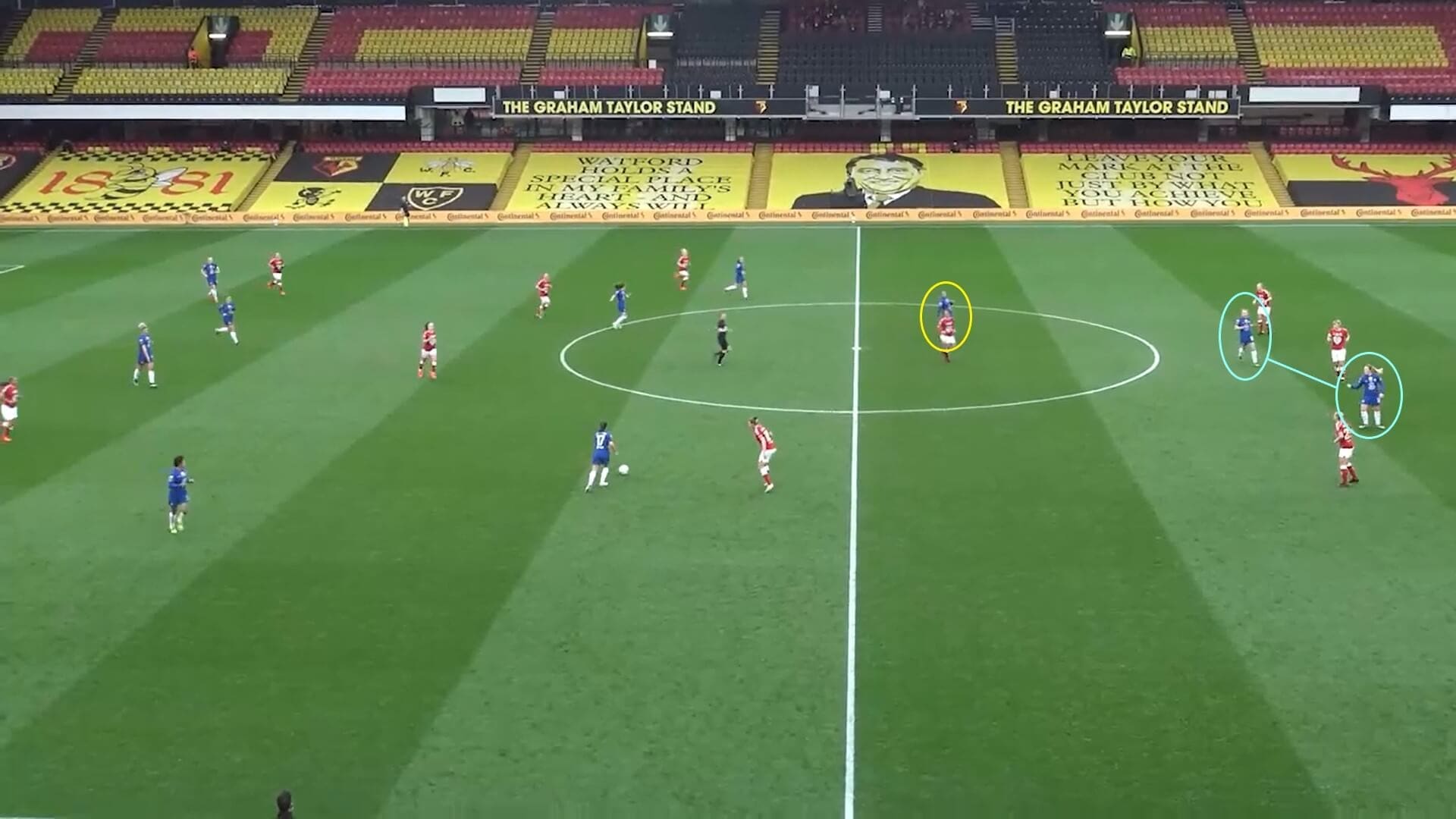
With the game won by half-time, Chelsea manager Emma Hayes made some early changes in the second half, taking both Sam Kerr and Fran Kirby off, with Erin Cuthbert and Niamh Charles operating as the two strikers afterwards. Neither are traditional strikers, but wide forwards, so this meant Chelsea needed a different tactical approach. We can see in this image how both have pushed up the field, taking the Bristol defenders with them, and this has created more space in between the Bristol lines for Chelsea to work in. Reiten, in the yellow circle, now has more space to create chances for her teammates. Cuthbert and Charles are both quick attackers who can get behind opposing defenders, and the aim of bringing them on was clearly to stretch Bristol out more in the second half, making it harder for them to get back into the game.
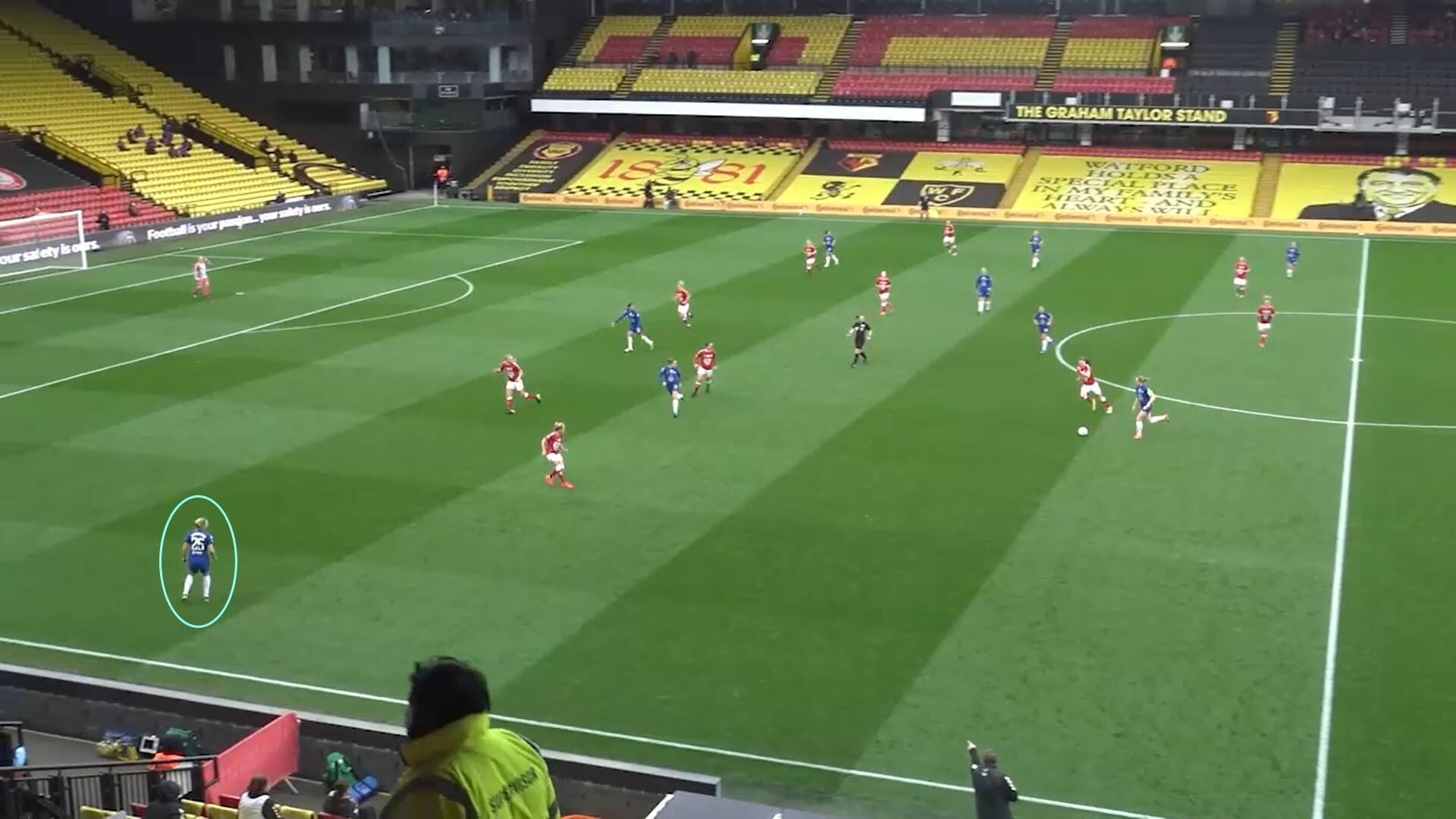
One major notable feature of Chelsea’s game was that the full-backs, Maren Mjelde and Jonna Andersson, were tasked with controlling the wings. This allowed the attackers to move more central, therefore increasing the chances they could create in the final third. This was also another way that Chelsea looked to isolate Bristol’s central defenders, moving their full-backs behind the Bristol wing-backs, therefore keeping them away from each other. Chelsea started with Jessie Fleming and Guro Reiten as their wide attackers, but their aim was clearly to bring those players inside much more, with Fleming not a traditional winger, and Reiten working with the forward line from central positions, as we have already looked at.
Fran Kirby’s role
We have already partly focused on Fran Kirby in this game, but she was without a doubt Chelsea Women’s most important player on the field. She had a hand in all six goals, scoring twice and setting up the other four, and this type of performance is no different to what we have seen from her all season.
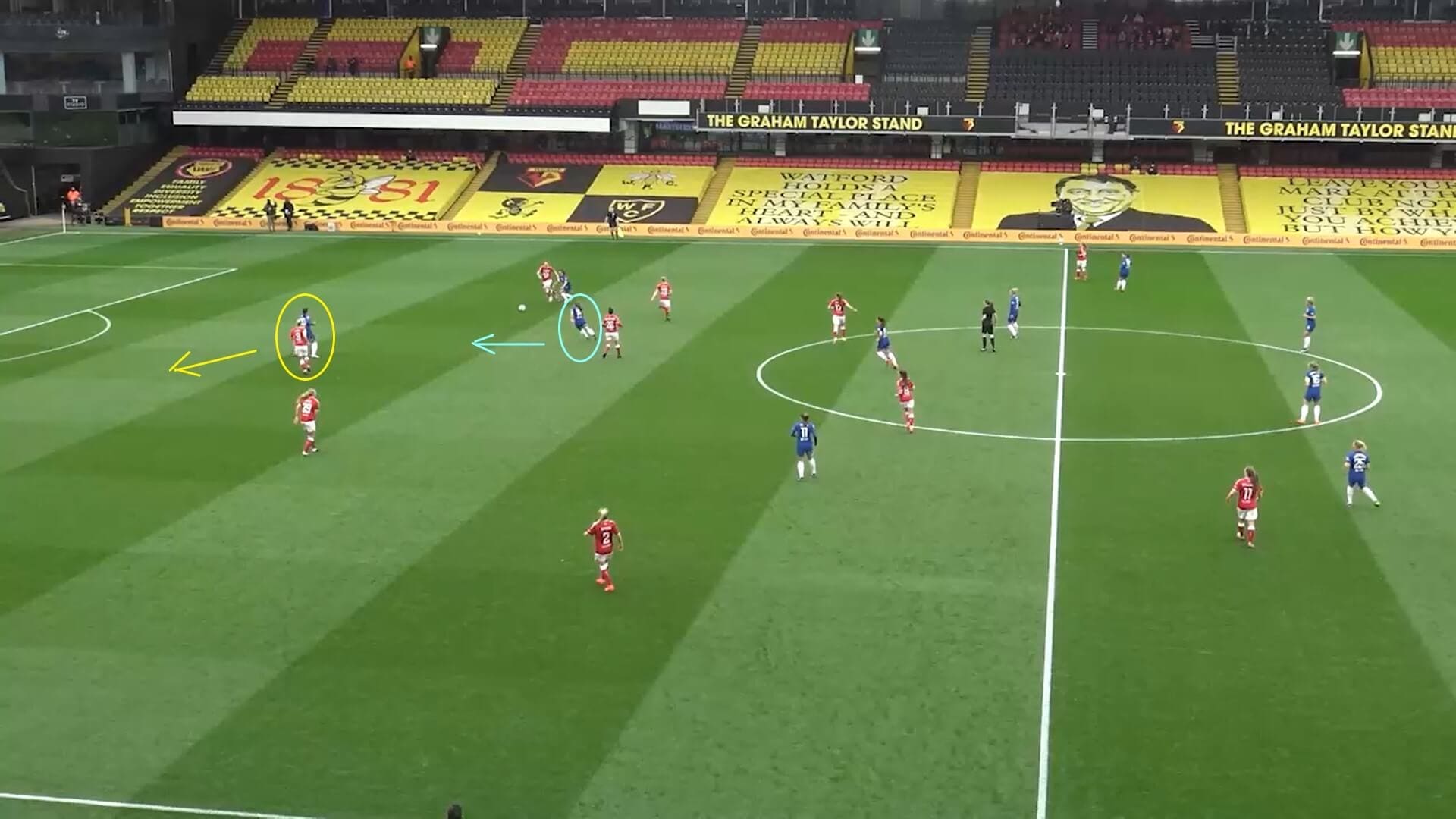
One of Kirby’s main strengths is anticipation of where the ball will go, before it has even been passed. Bristol City Women have the ball in their half here, looking to move it across into the central channel. However, as the blue arrow shows, Kirby moves into that area to intercept the ball and take it forward behind the defence.
The knock-on effect of this is that striker Sam Kerr, in the yellow circle, doesn’t need to win the ball, and can instead stay high up the pitch, among the Bristol defenders. By taking up this position, Kerr ensures that Bristol can’t close the ball down, because they would leave the Australia captain free behind them to move towards goal. As the yellow arrow shows, Kerr knows that Kirby will win the ball and move forward here, and so moves diagonally backwards, giving Kirby space to attack into, and now Chelsea have a front two from this interception and advance forward. Therefore, we see the role Kirby played in Chelsea’s attack.
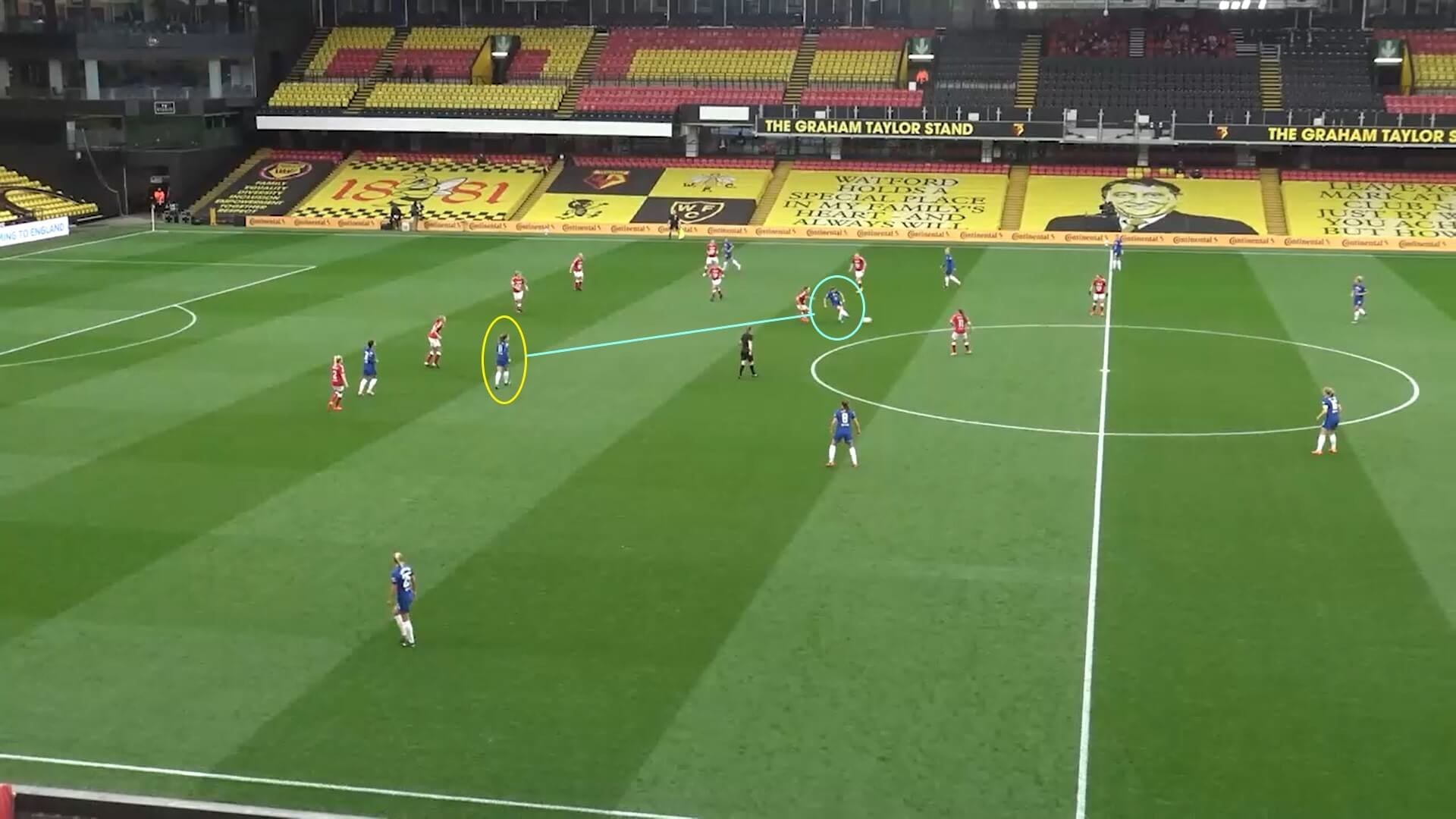
Kirby constantly looked to move into pockets of space, giving her team passing options around the pitch. However, what is particularly important here is that Guro Reiten moves into the forward line to replace Kirby. This is another thing that came from the three-player attacking structure, as it meant that, if one of the players moved out of position, another would take it up, meaning Chelsea always had a player amongst the Bristol defenders, keeping their attacking presence up.
This image shows the wider partnership between Reiten and Kirby, as the two attack-minded forwards supporting Sam Kerr in this game. Their ability to fill gaps left by each other, as shown in this image, ensured that Chelsea were never short of options to move the ball to, or ways to link the midfield and attack. The positioning of Reiten in this situation is particularly important, as it ensures that Bristol can’t all close Kirby down, because that would leave the Norway international in open space to attack their goal. It also allows Kerr to stay ahead of the ball, rather than moving back to make it easier for Kirby to find her with the ball; Reiten’s positioning provides that link.
Kirby’s positional awareness in these situations meant she asked plenty of questions of the Bristol defence, and her performance and influence was a key reason why Chelsea won the match.
Bristol City Women’s tactics
Under Matt Beard, we have seen an improved Bristol City Women, with a few new tactics introduced to make them more difficult to play against. In this game, they looked to keep Chelsea Women at bay as much as possible, which came from their 3-5-2 formation.

Here, we see how there are three distinct sections to their setup. The role of the wing-backs is to dominate the wings, getting forward to support the attack and then running back to help the defence when the team lose possession. We can see how Chelsea’s players are between the lines here, with Bristol looking to trap them in these areas. This would in theory make it harder for Chelsea to move the ball in transition from defence to attack, because Bristol could make their defenders pass across the pitch when there were no options available further up the field. However, as we have already established, Chelsea nullified this by playing with a wide defensive shape, pushing their full-backs higher up the field to control the wings, and their midfielders could overload the midfield as a result.
The other thing about this formation from Bristol’s point of view is that it allows them to have a second striker in attack. We have often looked at Bristol and seen how Ebony Salmon is left at the top on her own. Even with her pace, this has made it easy for opposing defenders to surround her and prevent her shooting at goal, thereby stopping Bristol attacking with freedom. However, with Charlie Wellings playing alongside Salmon at the top of the field, Bristol now have another attacking option, making it harder for opponents to surround them and easier for Bristol to create goalscoring chances.
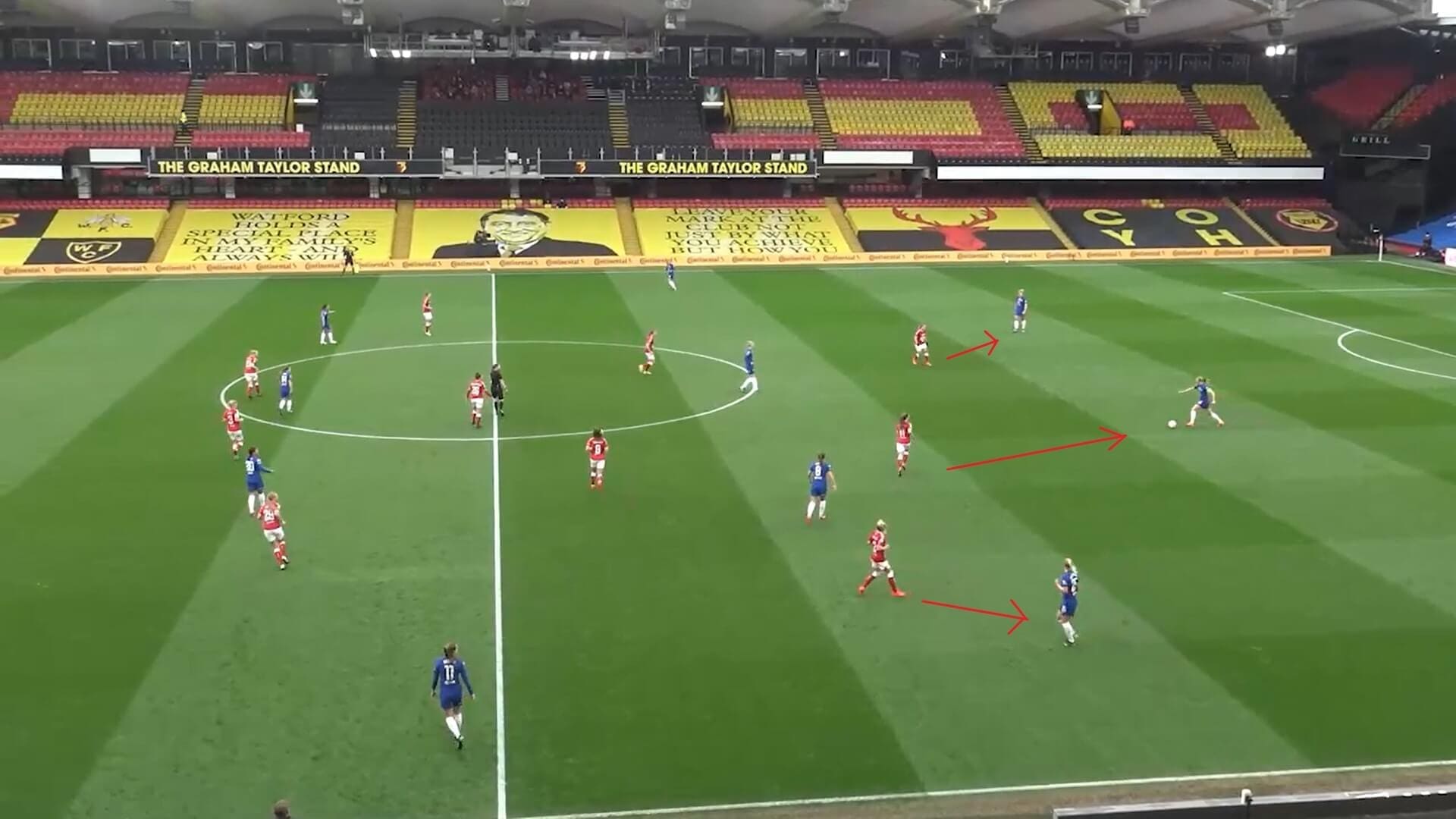
Playing with wing-backs also allowed Bristol to press the defenders when Chelsea had the ball at the back. Here, we see how right wing-back Faye Bryson has pushed up the pitch, with her, Wellings and Salmon each choosing an opponent and closing them down in turn. As soon as the ball was passed to another, the next Bristol player went, and so on. This tactic aimed to take time away from Chelsea in possession, with Bristol hoping to force them into making a mistake and then taking advantage to create a goalscoring chance.
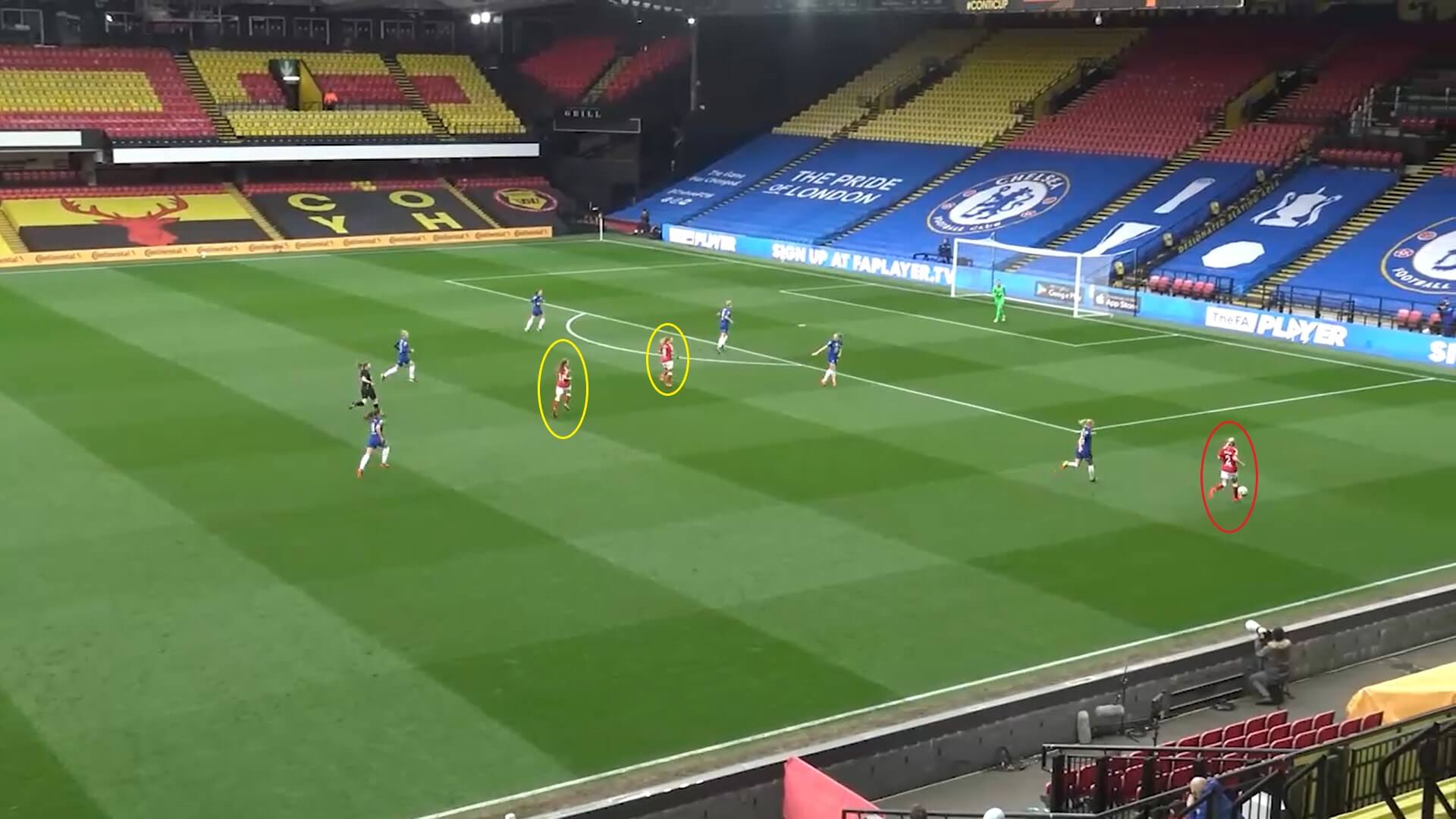
The other thing that came from playing with wing-backs and two strikers is that it gave them more options to move the ball to in the box. Again, this was the theory behind it, but the issue here is that Salmon and Wellings are behind the Chelsea defenders, outside the box, meaning that they can’t get on the end of any ball crossed in by Bryson from the wing. Chelsea’s defenders are doing well to surround them here, but this is one clear reason why Bristol had good tactics but couldn’t make the most of them. This was not just something that we noticed in this game, but has been a constant feature of Bristol’s general attacking play, and is why they struggle to score goals.
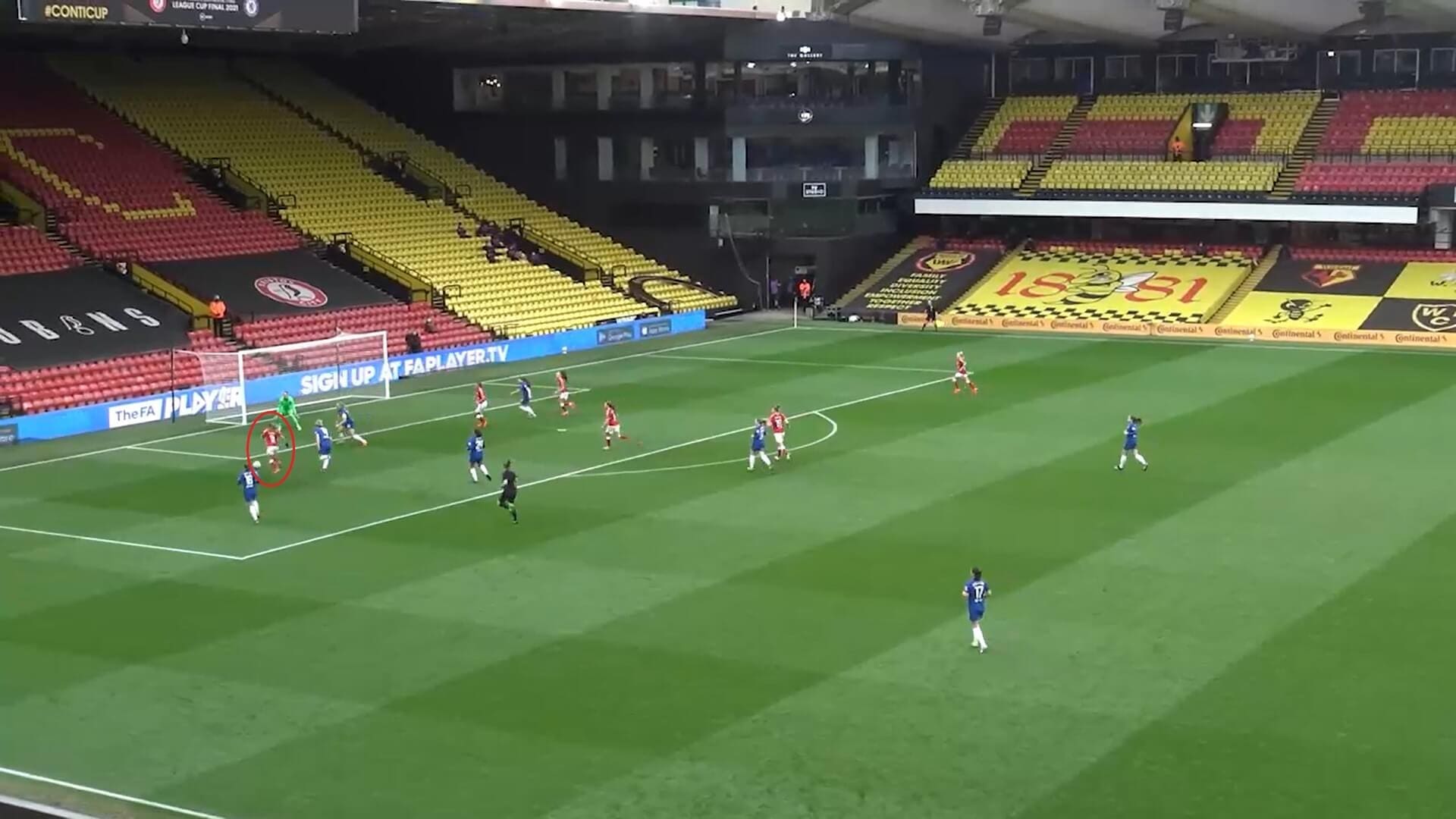
As mentioned, it wasn’t that Bristol didn’t have chances of their own to score. This image shows their best opportunity, with Ebony Salmon in the box and shooting at goal. However, it goes straight at Chelsea goalkeeper Ann-Katrin Berger, thereby wasting the opportunity. Salmon is Bristol’s most dangerous player, but it was moments like this where they lacked composure in the final third that made their overall game a frustrating and disappointing one. As we have established already, they had a clear plan for how to play the game, but just couldn’t make it work.
Conclusion
In conclusion, we have looked in this analysis at how Chelsea Women used clever tactics to overcome Bristol City Women’s setup, particularly in attack, where Fran Kirby played a crucial role in converting chances into goals. Bristol will be disappointed with the loss, but should be happy that they did make Chelsea think at times about how to break them down. However, what they lacked was the quality on the ball to take their chances, otherwise it could have been a closer result on the day.





Comments